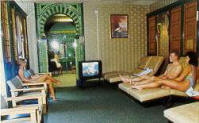The Turkish baths were a Christmas gift from Andrew Carnegie, the
 American steel magnate and philanthropist, to the people of the town where he was born, replacing baths which he had given in 1877. Designed by the Edinburgh architect Hippolyte Jean Blanc, they were built at a cost of around £45,000. The foundation stone was laid on 16 July 1902, and the baths were opened almost three years later on 31 March 1905.1
American steel magnate and philanthropist, to the people of the town where he was born, replacing baths which he had given in 1877. Designed by the Edinburgh architect Hippolyte Jean Blanc, they were built at a cost of around £45,000. The foundation stone was laid on 16 July 1902, and the baths were opened almost three years later on 31 March 1905.1
The outside of the building, in Classical Revival style, is faced in grey stone. The interior walls were decorated with polychrome glazed tiles, mainly blue and green, and 'the use of horseshoe arches at openings and niches, as well as a proliferation of traditional curvilinear patterns', emphasize The Moorish theme.2 The wall tiles were complemented by mosaic floors and, where walls were plastered they were decorated in pleasing soft tints.
By contrast, the cooling-room, though furnished with curtains and carpets supplied by a local company, J & T Scott of Edinburgh, seemed at the time,
a veritable Turkish apartment with its carved and decorated wood screens, and wall surfaces all elaborately treated in positive colours of rich reds, blues, and gilding all forming a pleasing and attractive eye scheme adding to the perfect comfort of the bath.3
In addition to the hot rooms and the cooling-room, the Turkish baths included a shampooing room, a Russian steam bath, plunge pool, showers and dressing rooms. There were also a number of slipper baths but these were replaced on 27 February 1938 by an Aeratone foam bath.4
Further research is needed to determine how well these beautiful baths were used at different stages of their life. During the year 1913-14, a period which included the beginning of WWI, there were 2,710 bathers (556 females and 2154 males), and although in 1928 there were 3,507 bathers during the year (1,211 females and 2,296 males),5 that was still only an average of just under 11¼ per day.6
The Turkish baths were closed during December 2008, although the rooms are now used for other purposes.
